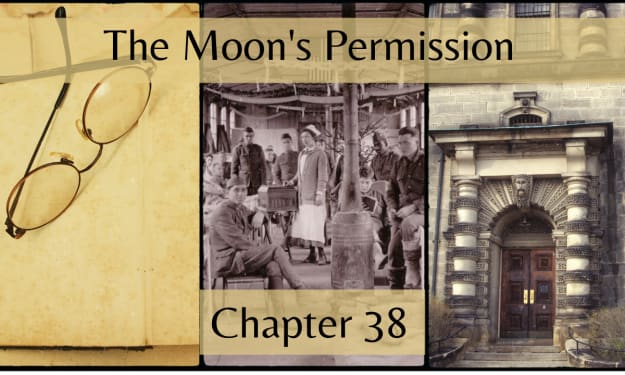In Beauty All is Made
An Essay about the Navajo Code Talkers in WWII

In Beauty all is Made
In Beauty all is Restored
~ Navajo Prayer
Newmiller, W. (2005). The Navajo Code Talkers and Their Photographer. War, Literature & the Arts: An International Journal of the Humanities, 17(1/2), 6–21.
Nez, C., & Avila, J. S. (2018). Code talker. Dutton Caliber.
Note: Below is my final paper for the WWII class I recently finished. I just wanted to add a bit of note now that it’s not in class. The Code Talker book is amazing and everyone should read it. Judith Avila was gracious and welcoming to me, even in our brief conversation. The impact of the Navajo on WWII is immense, but the intrinsic value of the Navajo people existed before and after that, even if mainstream America couldn’t be bothered to notice. While Chester Nez’ story is primarily about WWII, there are also accounts of his experience in Indian boarding schools. If anyone had any ideas that those schools were a good thing, they should read his book.
Here starts the essay! :)
The Japanese had a head start in World War II. With established positions on islands across the Pacific. Among strategic sites were Iwo Jima, Saipan, Guadalcanal, and many others. The National World War II Museum (2017) displays a map that puts Japan in control of much of the Pacific theater, nearly to Australia, certainly close enough to attack Hawaii. Unlike the European theater, the islands in the Pacific were new terrain, new cultures, and new challenges. The Japanese had already dug in, but because they couldn’t break the new code provided by the Navajo Code Talkers, they often lost the element of surprise and ultimately the war. Kept classified until 1968, there was not a lot written about them before that. Secret for nearly a generation, the approach to the story of the Code Talkers accounts tend to follow one of two paths - being either very personal accounts or being more distant both temporarily and culturally.
Both approaches offer valuable insight into the cultures of the time and the cultures that came afterwards. By considering events from different approaches, the friction between a dominant culture and vibrantly alive minority culture becomes more apparent. The work of Nez and Avila and that of Newmiller are strikingly different both in scope and cultural starting points. One writes from the point-of-view of the dominant culture and from a position of status. Nez and Avila present point-of-view of personal experience with the Code Talkers and with marginalization. What a historian will be able to understand and know of any given event or circumstance will never be divorced from the experiences that they bring to the beginning of their studies of said event or circumstance.
Often when a writer speaks about a culture to which they do not belong, no matter that they seek to talk about the culture and experience of others, they also illuminate their own culture of origin. William Newmiller (2005) retired from the US Air Force in 1993 and has since taught at the United States Air Force Academy, while achieving multiple publications. His LinkedIn profile photo shows an elegant man with a silver beard and a nice suit. There is a comfortable confidence in being a member of the largest and most normalized group in a culture. His writing is almost lyrical, confident, as if written by the professor of English composition, which it was, portrays a comfortable grace with the world. Newmiller’s frame of reference is closer to the commanders who were not really sure about this new code talking option they’d been sent from the brass.
Chester Nez was one of the original twenty-nine Code Talkers. The name his family called him, before the preacher giving him a ride to the boarding school decided he needed a new one, was Betoli, which meant ‘light complexion’ (Nez & Avila, 2012, p. 32). Photos of Nez are easy to find. In WWII he was a lean young man with midnight black hair and a calm that belies the circumstances of the war. He recorded seventy-five hours of his experiences for Judith S. Avila, who actually wrote the book, which bears both their names has won multiple awards for her work, including: NM Press Women Zia Award, New Mexico-Arizona Book Award, San Juan College-Four Corners Community Read Selection, NPR (National Public Radio) on-air read ( J. Avila, personal communication, May 25, 2021). The voice in the book is strikingly different from Newmiller’s voice. Nez, through Avila’s work, paints a world and a war that are intimate and vivid. In their work, Nez’ motives for joining the US Marines were multifaceted and deeply rooted in the Navajo culture that nurtured and sustained Nez.
The contrast between the two pieces is deeply pronounced. Each author discusses motives of these young men who would become the Code Talkers. Each author came to different conclusions about their motives for joining the US Marines. In multiple places throughout his work Nez speaks of duty, of wanting to protect his people, which included America at large. Newmiller describes the motives of the Navajo men in simplistic ways, “... the promise of work and an attractive uniform drew the interest of the sheepherders.” (Newmiller, 2005, p.4). When doing field work, the answers a person is willing to accept as true are likely aligned with the answers expected to be true. There is no reason to doubt Nez’ account of his own motives, nor the motive of the men he worked so closely with. Likewise, it is easy to imagine a flippant answer from an elderly Navajo that he joined the US Marines for the color of the uniform. To accept that answer though, one must believe that these men who created and maintained the most unbreakable code were simple minded and unspeakably naive.
Both works show awareness of the perceived separation between mainstream American culture and Navajo culture. Nez speaks openly about fear of acceptance from mainstream society, of actual moments where he was mistaken for being Japanese in wartime and hostility confronted in civilian life as well (Nez & Avila, 2018). Newmiller’s connection to the separation of cultural groups is much more subtle with a condescension that is so ubiquitous that to a mainstream reader it could feel comforting in its normalcy. This does not diminish the value of his paper, indeed it helps to explain why white soldiers on a Pacific island would assume darker skinned soldiers in marine uniforms had obviously stolen them.
Newmiller’s paper’s subtitle, ‘Once they were sheepherders’ highlights and simplifies the Navajo, even suggesting that by joining the US Marines they might have become something more. He uses a motif of European heroic templates with references to Joseph Campbell and the hero’s journey to celebrate men who accomplished so much, very likely saving the larger country around their own land, but that celebration comes through a European template, through American institutions. Beginning from a more syncrinstic worldview, Nez’ account is grounded in a more egalitarian respect for cultures not his own, even with a deep internal knowledge of the rightness of his own experience. History, moreso even in a pluralistic society such as the United States, is the story of friction between groups, adjustments, accommodation, and innovation.
While Newmiller’s work began from the point-of-view of an outsider to both Navajo culture and Japanese culture as he discusses the Japanese man who came to photograph the Navajo, his point-of-view never overlaps into belonging to nor truly understanding Navajo culture. He begins and ends as a distant external reporter, recording interactions between other cultures and trying to realign them against the heroic templates of his own culture. Avila begins as an outsider to Navajo culture. As a woman she also does not come from a powerful position within dominant American culture. Her immersion into Navajo culture and Chester Nez’ life experience allow the point-of-view of her narrative to center on the culture that motivated and sustained the Code Talkers, before, during, and after the war.
Seeking to understand who their respective works may have influenced them, both authors were asked to comment. While Newmiller’s piece was smaller, it was still published by an academic journal under the umbrella of the United States Air Force Academy. As of May of 2021, he was still listed on the publishing academic journal’s website. At this time, no response about his experience with his paper has been received. Avila has a website that is not affiliated with a larger organization and was also asked to comment on her experience, to reflect on the process of telling Chester Nez’ story. The was her response:
The image that comes to me first when I think of Papa (he asked me to call him Papa) was his gentle, humble kindness. Even when talking about wrongs he had experienced in life, he always kept a measured demeanor. His attitude was always, “Yes, that was bad, but things are getting better now.” He also applied this calm acceptance to his own life in that he felt he had just “done his duty” in WWII. He did not see himself as a hero, and often voiced puzzlement that I wanted to write about him. He’d tell me, “There were other men who were really heroes. I just did my duty.”
He was my hero. ( J. Avila, personal communication, May 25, 2021)
Comparing these two very different accounts of the Navajo Code Talkers’ experience and place in the American story, considering them both, the value and strength of America’s nature comes more into focus. The Navajo Code Talkers brought a tool to the American war effort that no other group could have done. The strength of their culture, the complexity of their language, the richness of their moral sense that required them to do their duty are America treasures that could not exist if the boarding schools had been more successful in homogenizing culture. The greatest strength in America is her ability to recognize the treasures in non-dominant groups and grow from them. There is room for many voices and they are all valuable.
References
Avila, J. S. (2018). Judith Avila's Writer Website. https://judithavila.com/.
This website showcases the written work of Judith Avila. It was important as it provided a means to reach out to her.
LinkedIn. (n.d.). William Newmiller. Profile: William New Miller. https://www.linkedin.com/in/william-newmiller-79b72714/.
William Newmiller profile on LinkedIn. This was a source of personal information, fleshing out the biography of the man who wrote one of the pieces discussed above.
Newmiller, W. (2005). The Navajo Code Talkers and Their Photographer. War, Literature & the Arts: An International Journal of the Humanities, 17(1/2), 6–21.
This article was found in the Bellevue University library. The author of the piece is a professor at the United States Air Force Academy and electronic editor for the Journal of War, Literature & the Arts. He retired from the Air Force in 1993. He is also a multi-published author. His article, as discussed in this essay, represents the point-of-view of the respected mainstream voice in American culture.
Newmiller, W. (2005, June 20). https://www.wlajournal.com/wlaarchive/17_1-2/newmiller.pdf. The Navajo Code Talkers and Their Photographer. www.wlajournal.com.
This version of the article is more complete, includes an additional letter from Newmiller and additional artifacts related to the Code Talkers. The quality of the photos is also better. It is included in this bibliography because of the additional artifacts it includes as well as its relevance to the author of the piece.
Nez, C., & Avila, J. S. (2012). Code talker: the first and only memoir by one of the original Navajo code talkers of WWII. Berkley Caliber.
This book contains the account of Chester Nez’ life as composed from audio tapes by Judith Avila. The experience centers on Nez’ experience in WWII, his motives for joining the US Marines, the creation of the Navajo code, and his experience of healing post war.
The National World War II Museum. (2017, July 10). The Pacific Strategy, 1941-1944: The National WWII Museum: New Orleans. The Pacific Strategy, 1941-1944. https://www.nationalww2museum.org/war/articles/pacific-strategy-1941-1944.
The National World War II Museum is located in New Orleans and contains maps and other information that is useful for understanding the Pacific theater in World War II. The physical campus contains exhibits on all theaters of war in WWII. Their mission is to educate and inpsire.
About the Creator
Duointherain
I write a lot of lgbt+ stuff, lots of sci fi. My big story right now is The Moon's Permission.
I've been writing all my life. Every time I think I should do something else, I come back to words.






Comments
There are no comments for this story
Be the first to respond and start the conversation.